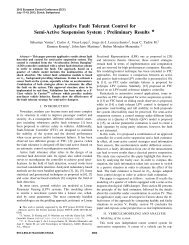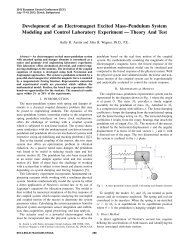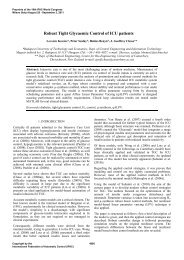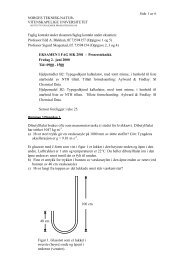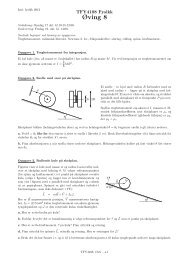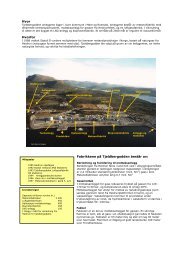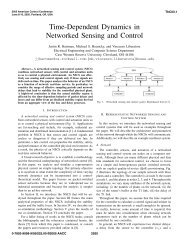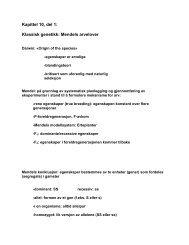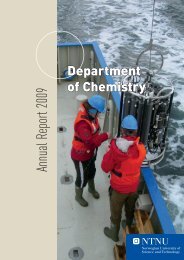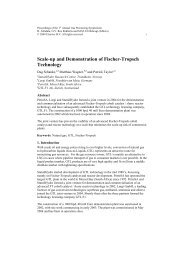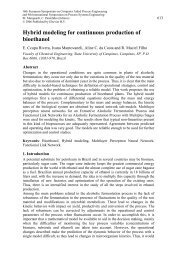Uniformity Control in Planetary Chemical Vapor Deposition Reactor ...
Uniformity Control in Planetary Chemical Vapor Deposition Reactor ...
Uniformity Control in Planetary Chemical Vapor Deposition Reactor ...
You also want an ePaper? Increase the reach of your titles
YUMPU automatically turns print PDFs into web optimized ePapers that Google loves.
17th IFAC World Congress (IFAC'08)<br />
Seoul, Korea, July 6-11, 2008<br />
GaAs film growth with a focus on reactor <strong>in</strong>let design for<br />
uniformity control and effective precursor utilization.<br />
Fig. 2. SiC film thickness (<strong>in</strong> µm) over a stalled wafer;<br />
reactant gas flow is from left to right. Experimental<br />
data are taken from Parikh, et al [2007].<br />
1.1 Depletion mode of operation<br />
In all the model<strong>in</strong>g and optimization studies cited, one<br />
or more of the precursors undergoes a sequence of gasphase<br />
decomposition reactions produc<strong>in</strong>g gas phase species<br />
capable of deposition. For example, <strong>in</strong> SiC deposition,<br />
silane undergoes the decomposition sequence<br />
SiH4 → SiH2 → Si<br />
where the atomic Si is primarily responsible for film<br />
formation. Likewise <strong>in</strong> GaN systems, trimethylgallium<br />
(TMG) thermally decomposes <strong>in</strong>to the dimethyl- and<br />
monomethyl subalkyls <strong>in</strong> the follow<strong>in</strong>g manner<br />
TMG → DMG → MMG → Ga.<br />
with the MMG and atomic gallium contribut<strong>in</strong>g largely to<br />
the film growth rate (Parikh and Adomaitis [2006]).<br />
Given these decomposition and deposition reaction pathways,<br />
the radial flow CVD reactor can be conceptually<br />
split up <strong>in</strong>to three dist<strong>in</strong>ct regions of reactor operation<br />
along the radial direction r: the first is the central region<br />
where the reactants heat quickly (see Parikh and<br />
Adomaitis [2006] for an example) due to the high reactor<br />
temperature required for epitaxial growth. After sufficient<br />
heat<strong>in</strong>g, the gas phase reactions commence, and the second<br />
reactor region is characterized by an <strong>in</strong>creas<strong>in</strong>g deposition<br />
rate with respect to r. The third and f<strong>in</strong>al region beg<strong>in</strong>s<br />
after the peak deposition rate; <strong>in</strong> this region, the species<br />
<strong>in</strong>volved <strong>in</strong> gas phase reactions have been depleted and<br />
only those important to film growth rema<strong>in</strong>, result<strong>in</strong>g <strong>in</strong><br />
a radial deposition profile that tapers off with <strong>in</strong>creas<strong>in</strong>g<br />
r. See Fig. 2 for an example of thickness data on a stalled<br />
wafer, illustrat<strong>in</strong>g how a relatively thick film is formed at<br />
the wafer lead<strong>in</strong>g edge and the nearly order of magnitude<br />
drop <strong>in</strong> thickness <strong>in</strong> the direction of gas flow, a film profile<br />
characteristic of the depletion zone.<br />
1.2 <strong>Uniformity</strong> control <strong>in</strong> the depletion zone<br />
In virtually all of the optimization studies cited, the<br />
reactor operat<strong>in</strong>g parameters were set so that the wafer<br />
was located <strong>in</strong> the depletion zone. Therefore, we exam<strong>in</strong>e<br />
the follow<strong>in</strong>g four issues def<strong>in</strong><strong>in</strong>g the ma<strong>in</strong> contributions<br />
of this paper:<br />
(1) Develop a simplified model of the deposition rate<br />
profile <strong>in</strong> the depletion zone;<br />
(2) Identify which design and operat<strong>in</strong>g parameters affect<br />
the deposition profile <strong>in</strong> this zone to determ<strong>in</strong>e which<br />
parameters are most effective for controll<strong>in</strong>g nonuniformity;<br />
(3) Determ<strong>in</strong>e the range of the parameters where reasonable<br />
uniformity (e.g., less than 1% mean squared<br />
non-unifomity) is to be found;<br />
(4) Exam<strong>in</strong>e representative published results to determ<strong>in</strong>e<br />
if the simplified reactor model and uniformity<br />
optimization results are consistent with the previous<br />
studies.<br />
2. REACTOR MODELING<br />
In the depletion zone of the reactor, no gas phase reactions<br />
take place and the reactor temperature can be assumed<br />
constant. We also assume pressure-<strong>in</strong>duced density variations<br />
are negligible, and viscosity, density, and all other<br />
gas properties are constant with respect to spatial position<br />
<strong>in</strong> this reaction zone.<br />
We def<strong>in</strong>e the flux of a gas phase species si <strong>in</strong> the r<br />
direction<br />
∂ci<br />
flux = civr − Di<br />
∂r<br />
where ci is the concentration of species i, vr the radial<br />
velocity, and Di the diffusivity of species i, a material<br />
balance on a two-dimensional differential element gives<br />
�<br />
1 ∂<br />
xirvr − Dir<br />
r ∂r<br />
∂xi<br />
�<br />
+<br />
∂r<br />
∂<br />
�<br />
�<br />
∂xi<br />
xivz − Di = 0 (1)<br />
∂z<br />
∂z<br />
where xi is the mole fraction of species i. For constant<br />
density ρ and viscosity µ, the equations of fluid motion<br />
can be written as<br />
�<br />
�<br />
∂vr ∂vr<br />
ρ vr + vz<br />
∂r ∂z<br />
= − ∂p<br />
� �<br />
1 ∂<br />
+ µ r<br />
∂r r ∂r<br />
∂vr<br />
�<br />
+<br />
∂r<br />
∂2vr vr<br />
−<br />
∂z2 r2 �<br />
�<br />
�<br />
∂vz ∂vz<br />
ρ vr + vz<br />
∂r ∂z<br />
= − ∂p<br />
� �<br />
1 ∂<br />
+ µ r<br />
∂z r ∂r<br />
∂vz<br />
�<br />
+<br />
∂r<br />
∂2vz ∂z2 �<br />
932<br />
together with the cont<strong>in</strong>uity equation:<br />
1 ∂<br />
r ∂r (rvr) + ∂vz<br />
= 0<br />
∂z<br />
where p(r, z) is the gas pressure and vz the vertical<br />
component of gas velocity.



